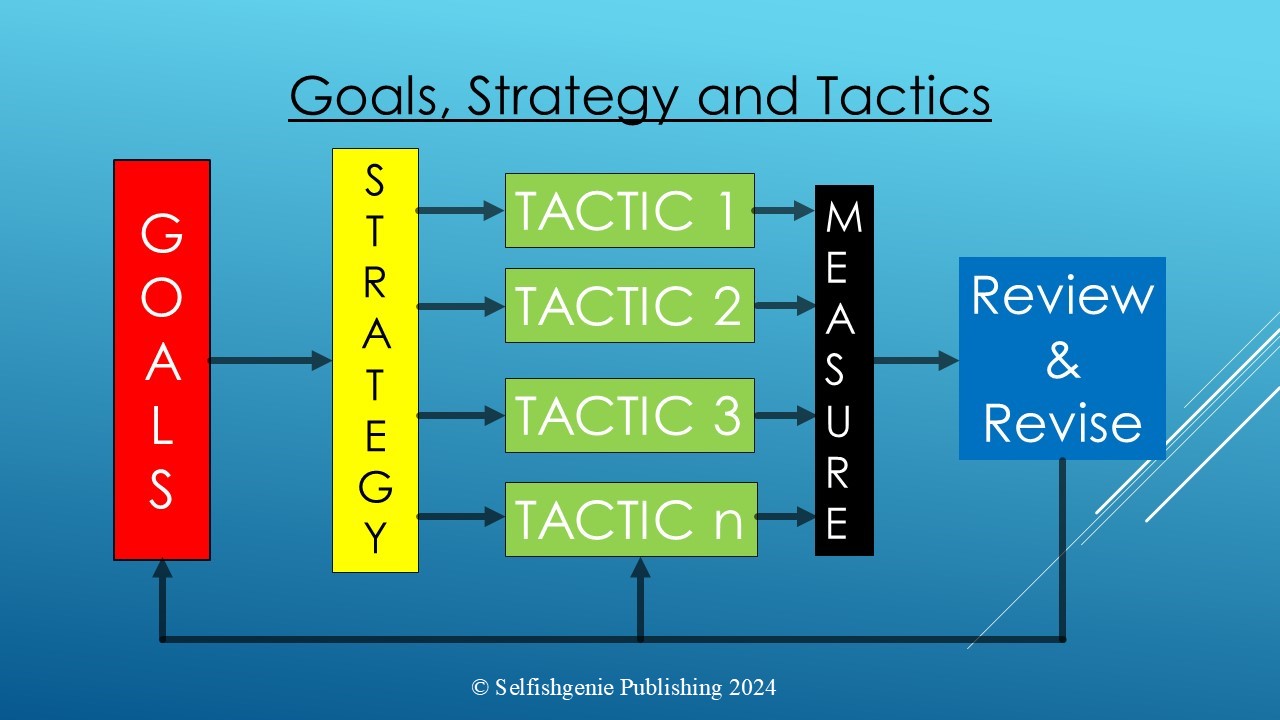 Do you know your book marketing strategy from your book marketing tactics? The difference is quite important. Think about it in terms of what you intend to achieve (strategy) and how you are going to achieve it (tactics). Tactics are shorter term and you may need to change them if they aren’t working. But strategy is a longer term thing. If you keep changing strategy every five minutes, you are unlikely to achieve anything. But you can’t decide on your strategy until you have first defined your goals. The connectivity between goals, strategy and tactics is often described in business speak as “getting your ducks in a row”.  What follows is used for illustration purposes only. We are not advocating any particular marketing strategy. That is for you to decide, based on your own goals. As an Indie author you probably know your major goal. It will be to sell as many books as possible (that may not actually be the goal for some authors. They may just want to write books and aren’t concerned with sales. But because you are reading a nook marketing blog, we’ll assume you want to sell books). That probably won’t be your only goal. We’ll stick a pin in the “Sell as many books as possible” goal, because we know that’s always going to be there. So, what other goals might you have?  Well, you may not want to spend a lot of money on marketing in order to sell your books, so there may be a goal related to achieving the major goal as cheaply as possible. You may also have a goal to build a loyal fanbase in order to make sure that you are able to make sales of future books, without having to start from scratch every time you launch one. You may have other ideas about your publishing goals. By all means add those to your personal list of goals.  “Selling lots of books” and “Not spending any money on marketing “ may be conflicting goals and your strategy may be unable to deliver both, so you may have to re-think which goal you want to achieve and remove the competitor so as not to get into any strategic conflicts. Having decided on your goals, you can now consider what strategy you must use to achieve those goals. Note the use of the singular version of the word. You may have several goals, but you only ever have one strategy. And if that strategy can’t deliver all your goals, you’ll have to reconsider your goals and perhaps prioritise them. Why only one strategy?  Because if you have more than one you will have difficulty focusing your efforts and resources on achieving your goals. If you divide your resources between strategies then it is likely that you won’t have enough resources to achieve all your goals. The two strategies may even be pulling in different directions, You create competition for yourself about what you consider to be most important. That is why I said that you have to consider your goals carefully, so that you focus on what is most important, rather than trying to achieve everything and ending up achieving nothing. Goals and strategy have to be aligned. For example, if your goal is to spend as little as possible on marketing your book, having a strategy based on paid advertising is contrary to your goal. Instead of achieving your goal, you will fail to achieve it – spectacularly.  So, let’s pick out one of the goals I suggested above: to spend as little as possible on the marketing of your books. One possible strategy for that is to use social media for your marketing, as that is free. So, your strategy is now aligned to your goal. Now you can think about your tactics. You might have several of these all directed by the same strategy. Tactic 1 might be to build up a following of readers on X (formerly Twitter) who will see your marketing messages and buy your books.  Tactic 2 might be to create great videos which you can use to market your books for free using TikTok and Instagram. Maybe even Facebook and X too. Tactic 3 might be to create “reader magnets” so you can build an email list, so you have a fanbase who have bought your current book and who are ready and waiting for news about your next book. Are those tactics aligned to your strategy? Yes, because 1. They all use social media (except the email list). 2. They are all free (except the email list). 3. They are proven ways of selling books.  What about that email list? To do this effectively you will normally have to subscribe to a suitable email management app, such as Mail Chimp or Mailerlite. Those subscriptions aren’t too expensive (certainly not as expensive as advertising) so they do align to spending as little money as possible. They only fail to align if the goal was “spend no money at all”. All you have to do now is implement those tactics and see if they are going to achieve your other goal of selling books.  What happens if they don’t achieve that over-arching goal of book sales? Well, in the first instance, you don’t change your strategy (at least, not yet). You have to identify why those tactics aren’t achieving your goals, and that means analysing your results. All your results. For tactic 1, for example you would have to dive into your X engagement data to find out how many people are reacting to your posts. Not just in terms of clicks to your book’s sales page, but in terms of likes and shares.  But you also have to identify how many of your followers are engaging in conversations with you, because it is engaged followers who are most likely to respond to your promotional posts, not those who just scroll past while looking for something more interesting. (Follower count is vanity. Engaged followers are sanity) I’m only using that as an example, of course. Once you have identified the problems with your tactics, you can then modify them or even scrap them and introduce new tactics. But the strategy of using social media remains unchanged.  Remember your goal was to spend as little money as possible on promoting your books. So perhaps you need to drill down into that a little bit and decide what “as little as possible” actually means. Maybe you need to set a budget that you are prepared to spend. With that budget you can then modify your tactics to spend a bit of money on creating better “content”, such as more exciting images or videos. That still sits within your strategy, while still meeting your goal. All you have done is to define your goal more tightly to identify what “as little as possible” actually means and then modifying your tactics accordingly. It is only when you have run out of suitable tactics that you consider changing your strategy. So, if you have been using social media for a year and you’ve changed your tactics to the point where you can no longer look at your goal of “as cheaply as possible” and not start crying, then you have to consider whether using social media for marketing is the right strategy. Or at least if using it as cheaply as possible is the right goal.  But by that time you will have built up a mass of evidence in the form of data that will be able to advise you on that. You won’t just be guessing. This is where the problem of “shiny objects” comes in. If you follow writing groups on social media you will often see someone raving about the latest shiny object they have used to sell their books. The temptation is to chase that same shiny object and try it out, which is where things start to go wrong. Because you have no idea what strategy that person was using. That is if they have a strategy at all and aren’t just jumping from one shiny object to the next - which isn't a strategy, it is just chaos. Remember your goal was “as cheaply as possible”, whereas their goal might be “make sales at any cost”. The shiny object could therefore fit in with their strategy – but it would undermine yours. Shiny objects are often short term in nature, a tactic at best, and, as we suggested above, strategy is a long term thing. So, our takeaways from this blog are illustrated in the graphic below. Put simply they are:
1. Strategy has to be aligned with goals 2. Strategy dictates which tactics are selected. 3. Measurement of the effectiveness of tactics drives review. 4. Review results in tactical changes. 5. Review can also result in the modification of goals. 6. It is only the modification of goals that changes strategy. If you try to miss out any of those steps, or to do them in the wrong order, it is likely that you will fail to achieve your goals. It may even cost you money in the form of lost sales, increased expenditure, or both. So it is really important to get your book marketing ducks in a row. If you have enjoyed this blog, or found it informative, then make sure you don’t miss future editions. Just click on the button below to sign up for our newsletter. We’ll even send you a free ebook for doing so.
0 Comments
Leave a Reply. |
AuthorThis blog is compiled and curated by the Selfishgenie publishing team. Archives
June 2025
|

 RSS Feed
RSS Feed